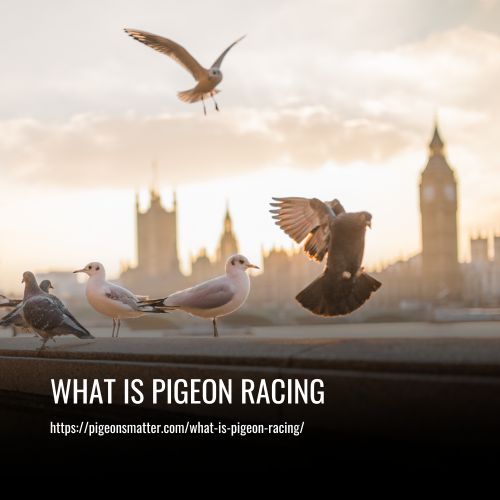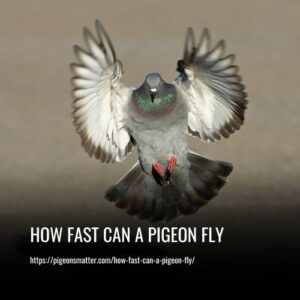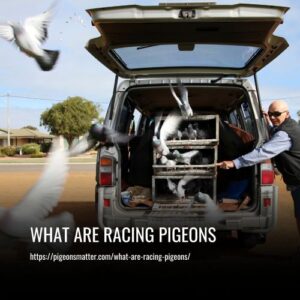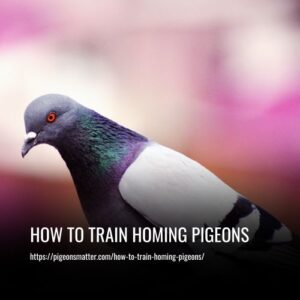Pigeon racing is a sport in which specially trained homing pigeons are released and then return to their homes over a measured distance. The time it takes for the pigeon to cover the distance is measured and compared to other pigeons in the race to determine the fastest bird. The sport requires a specific breed of pigeon called the Racing Homer, which is trained and conditioned for races of varying distances.
Different timing and measuring devices are used to determine arrival times, such as rubber rings in a clock or RFID tags. The sport may have originated as early as 220 AD and gained popularity in Belgium in the 19th century. However, the sport has experienced a decline in participants in recent years. One loft racing is a newer development in which birds are raced against each other under the same training regimen, regardless of the race trainer.

History of Pigeon Racing
Pigeon racing has been a popular sport for hundreds of years, with its origins dating back to the ancient Egyptians. They used homing pigeons to carry messages and it wasn’t until the 19th century that races were organized on a larger scale. At first, these competitions involved releasing two or more birds at the same time and then recording which bird returned first.
In modern times, pigeon racing is extremely popular all over the world. Races can involve up to several thousand birds being released from various locations and timed electronically as they return home. Owners use various tactics such as feeding them special diets and training them with specialized exercises in order to give their birds an edge over other competitors.
In addition to this physical challenge of endurance flying, pigeon racing also requires an element of skill in selecting the best birds for competition. Experienced owners know how to identify those breeds with potential for success and are able to gain competitive advantages through careful selection. Major events are held annually in countries like South Africa, Belgium, England and Australia, attracting thousands of spectators each year.
Racing Pigeon Lofts
Successful racing pigeons require more than just training. A well-managed loft is essential to instill in the birds a love and desire for their home. Before being allowed to fly freely, young birds must first become familiar with the area surrounding their loft and learn how to enter it.
A settling cage on the landing board or settling time in the loft aviary can help them learn. Feed is used to modify the bird’s behavior so they eagerly return home. By pairing the sound of a whistle or shaking of a can with being fed, you can signal to the birds when dinner is served.
Consistency is vital to performance, and knowing what to feed pigeons is crucial to keeping them healthy. With proper management and training, homing pigeons can race at fast speeds thanks to their love for their home.
How to Race Pigeons
Racing pigeons requires dedication and training, but it can be a rewarding hobby for those interested. To start, it’s important to provide a good home for the pigeons, treating them with kindness, feeding them well, and providing clean accommodations. Training should begin when the pigeons are around four to six weeks old, starting with short distances and gradually increasing as they become stronger flyers.
It’s necessary for them to gain experience flying in various weather conditions, except for heavy rain, thunderstorms, snow, and fog. Pigeons have been used for centuries for their homing abilities, and racing them has become a popular sport. While highly pedigreed pigeons can sell for millions of dollars, it’s possible to start racing without a large investment. Many pigeon enthusiasts are willing to give birds away to those starting out.
Racing pigeons requires dedication and time, as seen in the example of 16-year-old Joseph LaQuiere and his family, who travel with a trailer outfitted with a pigeon loft for their 30 birds. But for those interested in the sport, it can be a rewarding and exciting hobby.
Training Athletes
Building your racing pigeons’ muscles is an important step in their training process. Conditioning can begin around five miles from the loft, gradually increasing the distance by approximately 10 miles until 60 miles is reached. This allows the bird to develop the habit of navigation back to its loft and practice homing within one and a half to two minutes per airline mile.
Releasing birds from different directions after transporting them at least twice for the same distance can be beneficial. It’s essential to train them only in good weather when the sun is shining to avoid potential weather-related issues.
It’s important to only fly your birds until you have had several successful tosses at around 60 miles from the loft before mixing them with other people’s birds to reinforce the training. Gradually building their endurance and strength will help prepare them for future races.
Types of Races
There are two main types of pigeon races – club races and loft races. In club races, the pigeons are released at one location and fly back to their individual homes. The winner is determined by calculations since the lofts are at different distances from the release point. In one loft race, all the birds are raised from a single location, trained together, and released at the same time to race back to their home.
The South African Million Dollar Pigeon Race (SAMDPR) is a highly esteemed loft race, offering a substantial prize of $1.7 million. Frank McLaughlin of McLaughlin Lofts is a seasoned pigeon racer who has won every possible local and national award. Every spring, he exports more than 1,000 pigeons from the US to South Africa for the SAMDPR.
The pigeons are settled and trained in South Africa before being released under giant nets for a month before being free to fly into the sky. The winning pigeon from 2017 won $335,000 for the USA fancier. The American Racing Pigeon Union gave McLaughlin a Legend of the Sport Award for his achievements in racing.
Traditional Timing Method
The traditional timing method of pigeon racing involves the use of a stopwatch to measure the time it takes for a bird to fly from the release point to its destination. This method has been used since the inception of loft racing and is still widely used today by fanciers who prefer its simplicity.
When competing in a race, each participant releases their pigeons at the same time and records their own individual times when their birds arrive home. These times are then compared against one another with the fastest bird being declared the winner.
Despite its simple nature, traditional timing requires fanciers to be highly organized and accurate when recording their results. They must also take into account any external factors that may affect their times such as weather conditions or interference from other birds in flight.
Overall, traditional timing is still an effective way for pigeon fanciers to compete in races and has remained popular amongst those who appreciate its simplicity and accuracy. For these reasons, it remains a common choice for many loft racers today.
Individual Pigeon Training Techniques
Individual pigeon training techniques can be highly effective in preparing birds for competitive loft racing. These techniques involve providing the birds with specific activities and experiences that condition them to respond quickly and accurately in race situations.
Common individual training techniques include playing a tape recording of a gunshot, which helps the pigeon understand the signal for take-off; releasing it at gradually higher altitudes; flying in circles around the loft to accustom them to the layout of their home environment; and using flags or other visual signals to direct their flight path.
By providing these experiences, fanciers can condition their pigeons to properly respond to different race scenarios, allowing them to better compete against other birds. As such, individual pigeon training is an important part of any successful loft racing program.
The best way to ensure maximum effectiveness when training pigeons is by providing consistent exercises that challenge the bird’s physical and mental abilities. With patience and dedication, fanciers can help create a motivated and well-conditioned team of racers that are ready for any competition that comes their way.
Is Pigeon Racing Cruel?
Pigeon fanciers prioritize the welfare of their birds above all else, as an unhappy pigeon will not fly well. These fanciers form strong bonds with their birds, caring for them and ensuring they are comfortable, well-fed, and healthy. Pigeons are social animals that enjoy being around people and being handled gently. Many pigeons even recognize their owners.
Pigeon fanciers consider their birds to be pampered pets, and they take great care to keep them in top physical condition. The birds enjoy exercise and long flights, which are natural features of their physiology and are not forced upon them. The homing instinct that forms the basis of the sport is also a natural feature of pigeon behavior.
The RPRA (Royal Pigeon Racing Association) is committed to ensuring the welfare of the birds and will take action against any fanciers found to be treating their birds cruelly. Overall, pigeon fanciers are dedicated to providing their birds with a healthy and happy life, and the welfare of the birds is of utmost importance to them.
Pigeon Racing
Pigeon racing is a sport that utilizes homing pigeons, which are a specially bred and trained breed capable of flying long distances at high speeds. The domestication of pigeons dates back to ancient Egypt, and they have been used for messenger service throughout history, including during wartime.
Pigeon racing as a sport began in Belgium in the early 1800s and gained popularity in Great Britain, the United States, and France. The Fédération Colombophile Internationale is the world governing body for pigeon racing.
Pigeon racing involves training the birds to fly back to their home loft from varying distances and enter through trapdoors. They are banded at the start of a race and then liberated together by a starter who records the time of release. The birds ascend rapidly and head directly toward their lofts.
The fastest pigeon is determined by dividing the distance of the flight by the time consumed. Pigeons are capable of flying thousands of miles and have been recorded reaching speeds of over 90 miles per hour in races.
What About Other, More Traditional Pigeon Races?
Pigeon racing is a traditional sport where each pigeon keeper races their birds from the same starting point back to their individual lofts. The distance is calculated to the nearest yard, and all birds from a club or group of clubs are released together.
Numbered rubber race rings or electronic rings are placed on each bird, and the time it takes for them to return to their home loft is recorded. The club then calculates the average speed of each bird based on the distance and time taken. The bird with the highest average speed is declared the winner.
This form of pigeon racing requires careful training and preparation to ensure the birds are in peak physical condition for the race. The sport also requires a deep understanding of each bird’s behavior and tendencies to ensure they return safely to their loft.
FAQs
All pigeons in one loft race are in the same loft. They are raised together from 6 weeks old, trained together, and released from the same location at the same time. They then race back to the home loft over four races during the season, with each race getting progressively longer. The races all follow the same pattern.
In a one-loft race for pigeon owners, there is an option to transfer their pigeons for a yearling race with an additional fee, or they may choose to return or sell their pigeon to the breeder or another fancier.
If you’re interested in pigeon racing, it’s recommended to contact the regional RPRA secretary for your area. They can connect you with a local club or fancier who can assist you in getting started and answering any inquiries you may have. While it is a competitive sport, you’ll find that pigeon fanciers are willing to share their time and expertise.
Conclusion
Pigeon racing is a unique and exciting sport that has been enjoyed by people around the world for centuries. It’s a great way to bond with your birds, challenge yourself, and connect with like-minded individuals.
Whether you’re a seasoned racer or just starting out, pigeon racing is a thrilling hobby that’s sure to keep you on the edge of your seat. So spread your wings and give it a try – you never know where it might take you!


